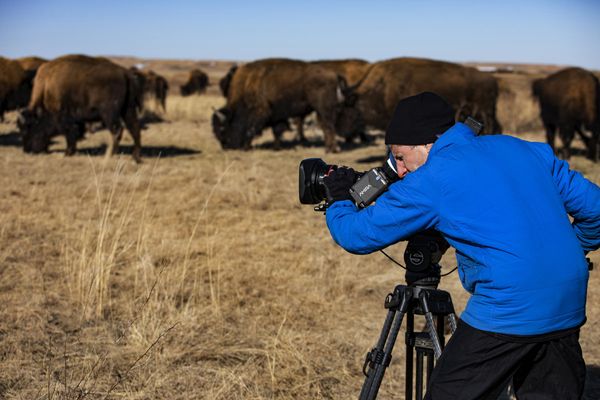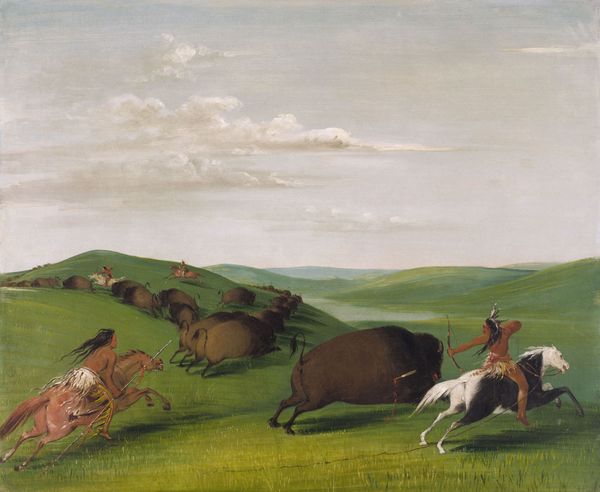With “The American Buffalo,” Ken Burns connects an icon of the natural world to our nation’s history
At the end of the 18th century, according to modern estimates, the American buffalo population numbered around 60 million, with herds roaming freely across North America. Bison sustained Indigenous people and played a key role in the ecological chain that kept the land verdant.
In less than a century, a sequence of events quickly decimated their numbers from millions to tens of thousands, until, by one count in 1889, there were only a few hundred left. Tracing the lineage of an animal would seem to be outside of Ken Burns’ usual range until, as he and his fellow filmmaking crew realized, one comes to understand how central the species known as bison bison is to our nation’s history and culture.
“The American Bison,” Burns’ latest entry, spends two nights and four hours tracing the swift near extermination of these animals due to white westward expansion and capitalistic greed, as well as the joint efforts between the federal government and Native tribal conservation effort to restore their numbers.
“The American Buffalo” is the first title in Burns’ filmography that focuses on a beast as opposed to a person, national monument or war. It also establishes that it’s impossible to tell our nation’s story without close consideration of these animals and the history of the Native peoples who relied on them. Voices from Northern Plains tribes — including the Salish, Lakota, Mandan-Hidatsa and Blackfeet — and Southern Plains people — including the Comanche, Cheyenne and Kiowa — provide views from when the herds were plentiful and narrate their dwindling. Simultaneously, they recount their stories of land loss, forced assimilation, and like the buffalo, resilience.
“There is no story anywhere in world history that involves as large a destruction of wild animals as happened in North America, in the Western United States, between 1800 and 1890,” historian Dan Flores says in the film of what is the largest destruction of animal life discoverable in modern world history.
“There is no story anywhere in world history that involves as large a destruction of wild animals as happened in North America, in the Western United States, between 1800 and 1890,” historian Dan Flores says.
To this, fellow historian Rosalyn Lapier asks, “Why are Americans so destructive? . . . Why is that part of our story? Why is that part of our history?”
“The American Buffalo” was more than three years in the making, with pre-production beginning in May 2020 and filming commencing a year later. In a recent press conference, however, Burns and longtime collaborator and series producer Julie Dunfey explained that the production began gestating as far back as 1996’s “The West,” which Burns executive produced, and 1997’s “Lewis & Clark: The Journey of the Corps of Discovery.” Journal entries featured in “The American Buffalo” indicate explorers’ encounters with the creatures became so frequent that after a point, they were no longer remarkable.
Over the 10 years it took Burns’ team to produce 2009’s “The National Parks: America’s Best Idea,” it became obvious, he said, that they needed to “detach this story from the other narratives, come back and perhaps overlap and crisscross with some of those narratives.”
 The American Buffalo (Photo by Craig Mellish)While certain figures recur in these stories, such as Teddy Roosevelt, Charlie Goodnight, and obviously, Buffalo Bill, Burns explained that the process of making this film and others alerted him to “blinders” he and his team had on concerning the presentation of American history.
The American Buffalo (Photo by Craig Mellish)While certain figures recur in these stories, such as Teddy Roosevelt, Charlie Goodnight, and obviously, Buffalo Bill, Burns explained that the process of making this film and others alerted him to “blinders” he and his team had on concerning the presentation of American history.
“We began to talk about a particularly beautiful place like a Yosemite or a Yellowstone, and we would talk about it in terms of its ancient geological formation, perhaps, but then the moment when it was discovered by ‘white people,’” he told reporters. “And very early on in our process, we understood that we needed to sort of connect the dots between that early geologic period and that moment when it was ‘discovered,’ in quotes, by telling the story of the Native peoples who inhabited that place, and in many cases — in most cases — held that particular ground among the most sacred that they had.”
Approaching history through the lens of a species pushed to the brink of extinction makes watching part one, “Blood Memory,” feel as painfully uncomfortable as it does important. It re-emphasizes the buffalo as another plundered resource that nourished Native people but held monetary value to white hunters and merchants selling their hides and heads to people in East Coast cities.
“There were uncounted millions of the beasts. They didn’t belong to anybody,” one Pennsylvania hunter wrote. “If you could kill them, what they brought was yours. They were like walking gold pieces.”
A modern-day historian described the hunting run in another more relatable way: White fortune hunters and settlers took his people’s grocery stores. Tribes starved, and the insult was doubled when white entrepreneurs returned to harvest the animals’ bones from the land to be rendered in factories.
“The American Buffalo” is also a study of moral shifts, transformations and changes, aiding us in understanding that some of the individuals who partook in the wholesale slaughter of this species also came around later in life to advocate for their survival. Theodore Roosevelt, for one, marveled at the supposed necessity of eradicating the buffalo as a means of “solving” America’s so-called “Indian problem,” a stunning example of his overt white supremacy. Later, Roosevelt would be instrumental in creating reserves for buffalo herds to replenish.
 “Buffalo Chase with Bows and Lances” by George Catlin, 1832-1833. (Smithsonian American Art Museum)“The thing we’re proudest of is the room that the film makes for all of these other kind of molecule-changing observations,” Burns said. “So that, to me, is the foremost. And, of course, I think understanding the need for habitat of the [350,000], 375,000 bison alive today.”
“Buffalo Chase with Bows and Lances” by George Catlin, 1832-1833. (Smithsonian American Art Museum)“The thing we’re proudest of is the room that the film makes for all of these other kind of molecule-changing observations,” Burns said. “So that, to me, is the foremost. And, of course, I think understanding the need for habitat of the [350,000], 375,000 bison alive today.”
“The thing we’re proudest of is the room that the film makes for all of these other kind of molecule-changing observations,” Burns said.
This aspect of “The American Buffalo” meets us in modern times, when we can take heart in viewing the result of efforts made by men and women at the end of the 19th and the beginning of the 20th century to save the species from complete annihilation. If not for a few farmers taking in young bison here and there and allowing herds to multiply on their land, we would not have the privilege of seeing living buffalo today.
And yet, as Lapier pointed out to reporters, one of the concerns “as we move forward into the future . . . is the creation of large ecosystems for bison to live on and whether or not bison will be free-roaming animals.”
Want a daily wrap-up of all the news and commentary Salon has to offer? Subscribe to our morning newsletter, Crash Course.
All of our bison herds live in some form of containment. According to the National Parks Service, the Department of the Interior (DOI) supports 19 bison herds, the equivalent of 11,000 bison over 4.6 million acres of DOI and adjacent lands in 12 states. According to Burns, the federal government controls upwards of 20,000 buffalo in national parks and various wildlife refuges, with Native peoples caring for tens of thousands distributed among more than 80 tribes coordinated by the Intertribal Buffalo Council. The success in bringing buffalo herd numbers back into the tens of thousands from a low of a hundred is a “phenomenal story of what happens when we come together,” he said.
However, as a caveat, he described “The American Buffalo” as “really the first two acts of the three-act play, if you will, because at the end of the day, to save a species as a zoo animal or as an exhibition animal in a corral isn’t the same as saving them as wild and free — and that’s now going on.”
“The American Buffalo” airs at 8 p.m. Monday, October 16 and 8 p.m. Tuesday, October 17, on PBS member stations. Check your local listings.
Read more
about Ken Burns

